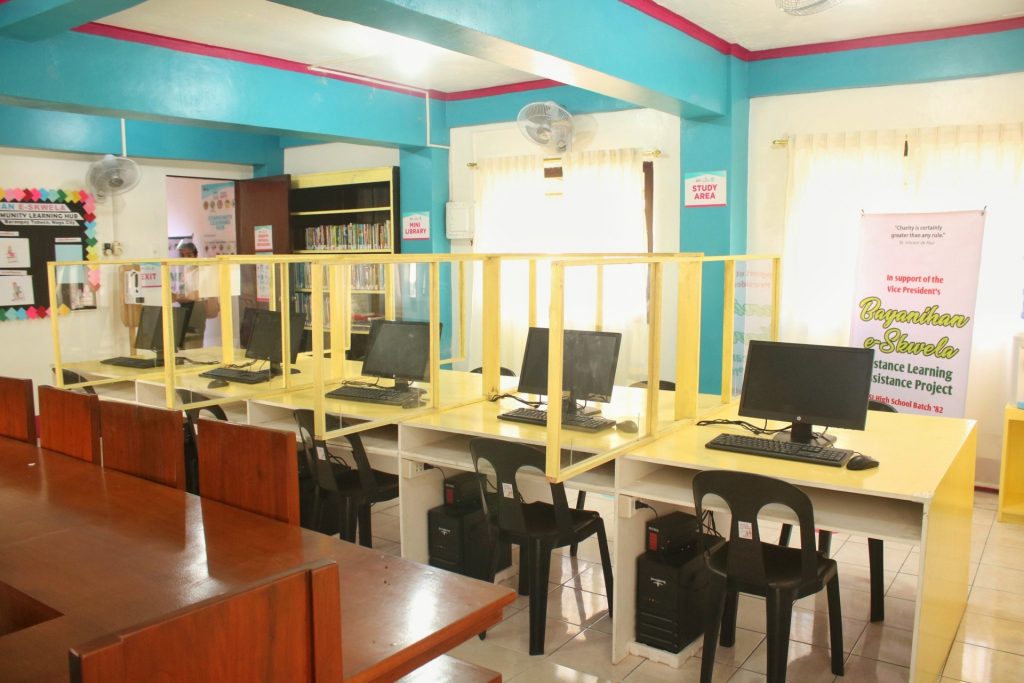Title
Bayanihan E-Skwela (Community Learning Hubs)
Organization
Office of the Vice President of the Philippines
Best Practice Focus Area/s
Citizens / Customers
Year Implemented
October 19, 2020 to Present
Summary
With the glaring limitations posed by the pandemic in the delivery of quality education, the Office of the Vice President (OVP), through its Bayanihan e-Skwela initiative, launched the OVP Community Learning Hubs (CLHs) in various parts of the country. A CLH is a learning facility that aims to provide learners with a safe and conducive space for learning; has the necessary tools, devices, and equipment; and has volunteer tutors who can guide them with their lessons. The hub is not intended as a substitute for formal education in schools but is meant to be supplementary to the current distance learning set-up.
Since its launch on 19 October 2020, the OVP has activated twenty-eight (28) CLH sites in various parts of the country, including the city of Pasig, the provinces of Rizal, Negros Occidental, Camarines Sur, Aklan, Quezon, Albay, Romblon, Isabela, Manila, Leyte, Antique, Iloilo, Cebu, Lanao Del Sur, and Sultan Kudarat.
Background and Problem
In order to prevent prolonged school disruption due to the COVID-19 pandemic, the Department of Education (DepEd) announced the Basic Education – Learning Continuity Plan (BE-LCP) in May 2020, which identified multiple learning delivery modalities that are relevant in providing a safe and healthy learning environment for the learners and teachers. Following the announcement, the DepEd began laying the groundwork for a “blended learning” modality, which would make use of radio, television, online, and modular learning for the incoming school year, as an alternative to face-to-face learning amid the public health situation.
However, the sudden necessity of blended learning coupled with the nationwide economic distress brought about by the health crisis made it even harder for marginalized families to help their children catch up with their studies. Furthermore, learners’ development in reading, writing, math, and other major subjects were further stunted.
The challenges faced by learners from marginalized families who already struggle with their finances are magnified by blended learning; they do not have the necessary internet connectivity or gadgets for their lessons, they live in environments that are not conducive for learning, and they have parents or guardians who do not have the capability to provide adequate support them for their lessons due to illiteracy or their work’s demands.
Solution and Impact
The OVP recognized these problems and immediately convened a team to conceptualize possible areas of intervention to ensure that all students will be given quality education despite the difficult circumstances. Thus, the Bayanihan e-Skwela initiative was born, with one of its pillars being the establishment of CLHs nationwide.

The OVP launched this project by first identifying potential pilot sites based on the following criteria: (1) the presence of a Civil Society Organization or Local Partner; (2) the LGU is interested in and cooperative with the project; and (3) the area is considered underprivileged and in need of support. Once a site was considered, a meeting was held with the local stakeholders, and steps were taken to start establishing the CLH, with defined roles among local partners.
Notably, in establishing a CLH in an area, stakeholders strived to meet these three key components:
- Beneficiary Insights. To know more about the families, needs assessment activities were conducted in select areas. Data was culled from surveys and available information from the local schools where the site is located. The LGUs also helped in identifying the priority beneficiaries based on a specific set of criteria.
- Volunteer Support. To support the implementation of the project, volunteers may be referred by the partner LGUs or from networks of the OVP coming from various sectors (women, youth, labor groups, etc.). The volunteers may come from the same barangay, or adjacent barangays where the hub is located.
Notably, In partnership with several non-profit organizations and enterprises with experience in the field of education, the OVP was able to train hundreds of volunteers. The training was done through:
- Social Learning Units where learning modules can be answered asynchronously through the Facebook group platform.
- Enrichment Sessions which are synchronous sessions facilitated via Zoom platform that aims to process all the knowledge the volunteers acquired from answering the social learning units.
- Site Identification. For an effective CLH, many considerations were taken. Notably, they must have been located in an area with a high concentration of learners, easily accessible to the learners, and conducive for learning.

Significantly, most of the sites chosen were daycare centers, halls, and other venues that were underutilized since gatherings are not allowed in the new normal. Sites that required refurbishing were endorsed to possible local partners who could help cover the expenses for the renovation. The project thus became a culmination of efforts among the LGU, the community, and the private organizations in the area.
Milestones/Next Steps
As of writing, the Community Learning Hub has mobilized ₱28.5 million, launching 129 sites across 43 provinces and 91 cities/municipalities from October 2020 to June 2022, benefitting a total of 8,216 students.
